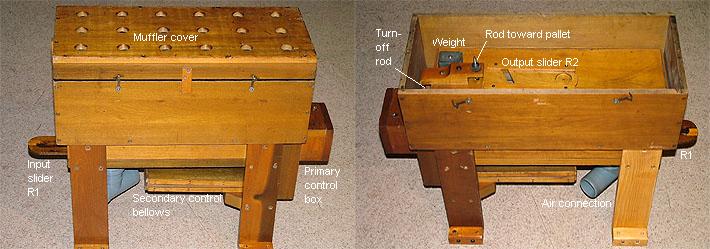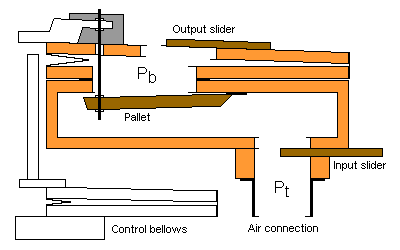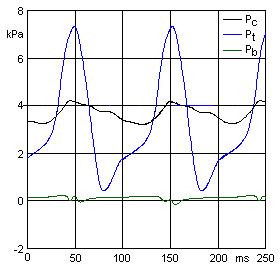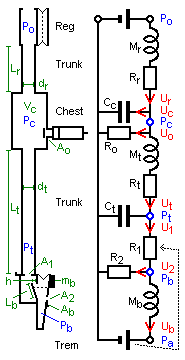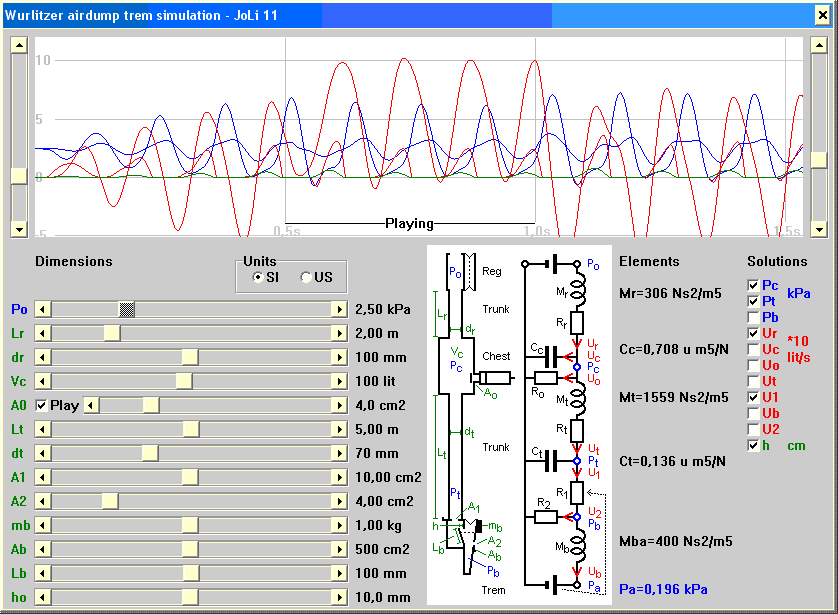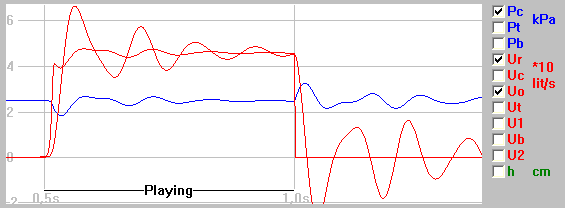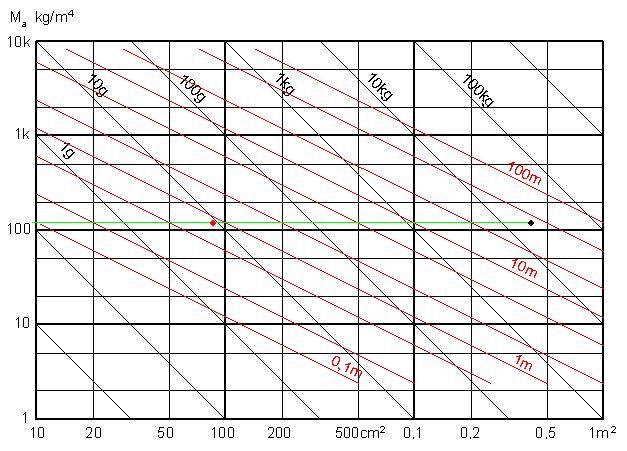Discussion
In an existing installation most parameters like trunk and
trem bellows dimensions are already given. Then you can
examine what happens when changing the parameters A1, A2, and mb supposed
to be the normal parameters for an adjustment.
The net airflow consumption of the trem is U1 which has
a waveform typically reminding of half sinusoids, skewed to
the right. This excitation shape is typical for many airflow
interrupting devices like reed pipes, diaphones, orchestral
reed and brass instuments, and the human glottis. Indeed the
whole trem system can be likened to a diaphone pipe, blown
backwards from its mouth at the supply regulator. Like in
the mentioned examples the pulse flow from the interrupter
is connected to a resonator, in our case the trunks and the
chest, to produce an amplified flow oscillation Ur at the
mouth, and which may reach quite high values. It should be
noted that part of a trem cycle this flow may go backwards
to refill the regulator. The regulator is supposed to
deliver a constant pressure Po. Even when it manages to do
so, its bellows lid will oscillate because of the
alternating Ur.
Example calculation: With Ur about
sinusoidal 100 lit/sec peak/peak at 7 Hz, then the volume
displacement in the regulator will be U/(2π *f) = 100/(2π*7) = 2.3 lit p/p.
That renders a lid oscillation about 6 mm p/p when the lid
area is 0.38 m2.
The regulator in this simulation is assumed to be perfect in
delivering a constant driving pressure. A practical one may
vary somewhat in static
output with its reservoir fill, depending on how its bellows
and spring/weight load match. This is a problem that has
minor influence, not accounted for here. A decently
constructed regulator usually holds its static pressure
within few percent. The initial version of this essay has
received some criticism because of this assumption that
consequently excluded the regulator from the simulated
network. The reason to exclude it is that otherwise the
total number of parameters would tend to be too high to
handle. The assumption is generally good as long as the
pulsating flow Ur
is not big enough to make the bellows bottom out.
However, after finding a working parameter set for the trem
and you know Ur,
then it is wise to run the accompanying regulator simulation
program to check how it can handle that flow.
A different thing is the important one, namely the inertia of the
regulator. This is its acoustical mass which is found from
bellows lid area and weight, including ballast if any.
Knowing these data you can account for its effect by adding
it to Mr
by an increase in the trunk length Lr.
Example calculation: With a
regulator lid weight m
= 15 kg, area A
= 0.38 m2, its acoustical mass is M = m/A2 =
15/0.382 = 104 Ns2/m5,
about one third of Mr
in fig 5. You can account for that by elongating the trunk
about 0.6 m.
It is important to understand this equivalence between
regulator lid weight vs. regulator to chest trunk length.
Both have the same effect to swamp regulator action what
regards changes in
airflow, but little concerning static conditions. This is
further elaborated below in the technical section about
trunks.
Following the lid, the regulator input valve will oscillate.
This will partly invalidate the reasoning above, since
regulator flow is not only its lid displacement flow, but
also refilling flow pulses. However this generally has a
relatively minor influence on regulator output, even when
its upstream pressure varies considerably.
The pressure Pt
at the trem input varies much more than the chest pressure.
There is a sharp pressure rise when the pallet closes, the
hydraulic hammer effect, an expedient to keep reliable
oscillation. It is noteworthy that the diameter dt of the
chest to trem trunk is of some importance here. If you make
it too large, then the linear air speed corresponding to Ut will be
small, reducing the hammer effect.
The trem input slider A1
limits the exciting U1
pulses and often appears useless, having little effect until
you make it rather small. It is sometimes left wide open to
allow for maximum pipe load which is controlled by Ao. If used
the trem function may deteriorate unless A2 is fine
adjusted.
|
